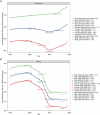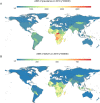Evaluating the global, regional, and national impact of syphilis: results from the global burden of disease study 2019
- PMID: 37452074
- PMCID: PMC10349077
- DOI: 10.1038/s41598-023-38294-4
Evaluating the global, regional, and national impact of syphilis: results from the global burden of disease study 2019
Abstract
Syphilis is a global public health concern. This study aimed to assess the global and regional burden of syphilis from 1990 to 2019. Disease burden was evaluated using disability-adjusted life-years (DALYs) and prevalence. Data were extracted from the 2019 global burden of disease Study, an open database available for download. Age-standardized rates (ASR) and estimated annual percentage changes (EAPC) were calculated to evaluate the syphilis burden over time. In 2019, the total number of prevalent cases of syphilis was 49.71 million worldwide. The ASR of prevalence was stable from 1990 to 2019 with an EAPC of 0.00 (95% CI - 0.10-0.11). The number of DALYs caused by syphilis was 7.36 million in 2019, reflecting a reduction of 16.38% compared with that in 1990 (8.80 million). The ASR of DALYs exhibited a decreasing trend from 1990 to 2019 (EAPC = - 1.01; 95% CI - 1.19 to - 0.84), with the highest rates observed in the younger age group (< 14 years old). In 2019, the highest ASR of DALYs was found in low sociodemographic index (SDI) regions (239.21/100,000), and the lowest in high SDI regions (3.14/100,000). Generally, the ASR of DALYs decreased as the SDI increased. The top three countries with the highest ASR of DALYs for syphilis were the Solomon Islands, Equatorial Guinea, and Liberia. While the global prevalence of syphilis remained persistently high from 1990 to 2019, there has been a recent decrease in the ASR of DALYs. Increased attention should be dedicated to younger populations and regions characterized by low SDIs.
© 2023. The Author(s).
Conflict of interest statement
The authors declare no competing interests.
Figures




Similar articles
-
Trends in the prevalence and disability-adjusted life years of eating disorders from 1990 to 2017: results from the Global Burden of Disease Study 2017.Epidemiol Psychiatr Sci. 2020 Dec 7;29:e191. doi: 10.1017/S2045796020001055. Epidemiol Psychiatr Sci. 2020. PMID: 33283690 Free PMC article.
-
Burden of esophageal cancer between 2010 and 2019 in Asian countries by geographical region and sociodemographic index: A comparison with global data.Thorac Cancer. 2023 Aug;14(24):2361-2407. doi: 10.1111/1759-7714.15026. Epub 2023 Jul 17. Thorac Cancer. 2023. PMID: 37455657 Free PMC article.
-
Measurement of the burdens of neonatal disorders in 204 countries, 1990-2019: a global burden of disease-based study.Front Public Health. 2024 Jan 9;11:1282451. doi: 10.3389/fpubh.2023.1282451. eCollection 2023. Front Public Health. 2024. PMID: 38264240 Free PMC article.
-
Temporal trends of tracheal, bronchus, and lung cancer between 2010 and 2019, in Asian countries by geographical region and sociodemographic index, comparison with global data.Thorac Cancer. 2023 Jun;14(18):1668-1706. doi: 10.1111/1759-7714.14912. Epub 2023 May 1. Thorac Cancer. 2023. PMID: 37127553 Free PMC article.
-
Global burden and risk factors of musculoskeletal disorders among adolescents and young adults in 204 countries and territories, 1990-2019.Autoimmun Rev. 2023 Aug;22(8):103361. doi: 10.1016/j.autrev.2023.103361. Epub 2023 May 23. Autoimmun Rev. 2023. PMID: 37230312 Review.
Cited by
-
Disparities in Syphilis Trends and the Impact of the COVID-19 Pandemic: A Joinpoint Analysis of Florida Surveillance Data (2013-2022).Cureus. 2024 Sep 22;16(9):e69934. doi: 10.7759/cureus.69934. eCollection 2024 Sep. Cureus. 2024. PMID: 39449915 Free PMC article.
-
Secondary Syphilis Can Simultaneously Mimic Cholestatic Liver Injury and Glomerular Nephropathy.ACG Case Rep J. 2024 Oct 11;11(10):e01538. doi: 10.14309/crj.0000000000001538. eCollection 2024 Oct. ACG Case Rep J. 2024. PMID: 39399246 Free PMC article.
-
Syphilis vaccine development: Aligning vaccine design with manufacturing requirements.Hum Vaccin Immunother. 2024 Dec 31;20(1):2399915. doi: 10.1080/21645515.2024.2399915. Epub 2024 Sep 11. Hum Vaccin Immunother. 2024. PMID: 39262177 Free PMC article.
-
Syphilis Clinical Complexity: A Dual-Case Study Illustrating Diagnostic Dilemmas and Management Strategies.Cureus. 2024 Aug 2;16(8):e65997. doi: 10.7759/cureus.65997. eCollection 2024 Aug. Cureus. 2024. PMID: 39221347 Free PMC article.
-
High Prevalence of Syphilis among Young Pregnant Women in the Brazilian Amazon: A Cross-Sectional Study Based on Clinical Records in a Public Health Reference Unit in the City of Belém.Pathogens. 2024 Aug 14;13(8):686. doi: 10.3390/pathogens13080686. Pathogens. 2024. PMID: 39204286 Free PMC article.
References
Publication types
MeSH terms
LinkOut - more resources
Full Text Sources
Medical

